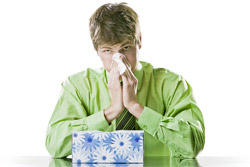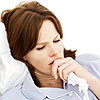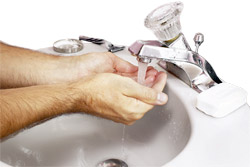- Introduction to cough and sneeze etiquette
- Why is cough and sneeze etiquette important?
- How to practise good cough and sneeze etiquette
Introduction to cough and sneeze etiquette
Cough and sneeze etiquette refers to simple hygiene practices everybody can take to prevent passing on respiratory infections like cold and flu to other people.
It is especially important that people who are sick with cold or flu practise good cough and sneeze etiquette. However, infections like cold and flu can be transmitted even before symptoms like sore throat and cough let you know you’re sick. So even when you’re perfectly healthy, it’s important to practise proper cough and sneeze etiquette.
Why is cough and sneeze etiquette important?

The droplets released during coughing and sneezing may be inhaled, or they may land on a person’s hands or hard surfaces where the virus particles can survive for hours. If a person touches contaminated surfaces, the virus particles may be transferred to their hands. If a person touches their face with contaminated hands, it may cause infection.
Get on top of your general health
Find and instantly book affordable GPs within Australia
How to practise good cough and sneeze etiquette
Good cough and sneeze etiquette involves taking steps to minimise the likelihood that someone else will catch your cold or flu when you cough or sneeze. There are many simple measures you can take.
Cover coughs and sneezes
- Cover your mouth and nose every time you cough or sneeze. Use a disposable tissue to cover your mouth or nose if possible.
- If a cough or sneeze sneaks up on you and no tissue is available, cough or sneeze into your upper sleeve. This prevents your hands becoming contaminated with cold or flu viruses.
Dispose of or clean contaminated products immediately
- Dispose of single-use tissues immediately after you cough or sneeze. Try to ensure a waste bin is available so that tissues can be disposed of (e.g. if you’re in bed with the flu, put a bin beside your bed so you don’t have to get up to throw your contaminated tissues away). If there is no bin, use a plastic bag to store contaminated tissues until a bin is available.
- If you cough or sneeze onto a hard surface like a desk or telephone, clean it immediately with a disposable disinfectant wipe to remove the cold and flu germs.
Ensure your hands are hygienically cleaned
Wash your hands with soap and water for at least 15–20 seconds every time you cough or sneeze.
- Wash your hands every time you touch a contaminated object like a tissue.
- If soap and water are not available, use alcohol-based hand sanitising products containing ≥ 60% alcohol. These products are also effective in removing cold and flu germs from contaminated hands.
Avoid touching the face
- Avoid touching your face with your hands (especially if you know they’re contaminated, for example if you’ve just wiped your sick child’s nose). Touching the face allows cold and flu viruses to enter the mucous membranes of the nose and eyes and cause infection.
Avoid close contact with others
- Stay away from work, school and other busy places as much as possible when you have an illness like cold or flu which causes coughing and sneezing.
- If you need to go to work or other busy places, avoid close contact with others, for example by not shaking hands and standing at least one metre away.
More information
 |
For more information on the common cold and influenza, types of influenza and treatments and tips for preventing influenza, see Cold and Flu. |
References
- Coughing and sneezing [online]. Atlanta, GA: Centres for Disease Control and Prevention; 28 December 2009 [cited 14 July 2013]. Available from: [URL link]
- How influenza is spread [online]. Melbourne, VIC: Influenza Specialist Group; 2013 [cited 14 July 2013]. Available from: [URL link]
- Prevention tips to limit the spread of colds and flu [online]. Melbourne, VIC: University of Melbourne; 11 April 2013 [cited 14 July 2013]. Available from: [URL link]
- Respiratory hygiene and cough etiquette [online]. Canberra, ACT: National Health and Medical Research Council; 16 June 2011 [cited 14 July 2013]. Available from: [URL link]
- Hand hygiene guideline [online]. Adelaide, SA: South Australian Infection Control Service; 18 November 2010 [cited 2011, Feb 22]. Available from: [URL link]
All content and media on the HealthEngine Blog is created and published online for informational purposes only. It is not intended to be a substitute for professional medical advice and should not be relied on as health or personal advice. Always seek the guidance of your doctor or other qualified health professional with any questions you may have regarding your health or a medical condition. Never disregard the advice of a medical professional, or delay in seeking it because of something you have read on this Website. If you think you may have a medical emergency, call your doctor, go to the nearest hospital emergency department, or call the emergency services immediately.

 Wash your hands with soap and water for at least 15–20 seconds every time you cough or sneeze.
Wash your hands with soap and water for at least 15–20 seconds every time you cough or sneeze.





